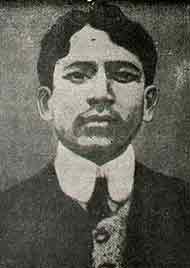Madanlal Dhingra
| Madan Lal Dhingra | |
|---|---|

Madan Lal Dhingra
|
|
| Born |
18 September 1883 as per his father's record Amritsar, Punjab, British India |
| Died | 17 August 1909 (aged 25) Pentonville Prison, London, Britain |
| Organization | India House |
| Movement | Indian Independence movement |
Madan Lal Dhingra (Punjabi: ਮਦਨਲਾਲ ਧੀਂਗੜਾ) (8 February, 1883 – 17 August, 1909) was an Indian revolutionary independence activist. While studying in England, he assassinated Sir William Hutt Curzon Wyllie, a British official, cited as one of the first acts of revolution in the Indian independence movement in the 20th century.
Madan Lal Dhingra was born on 8 February 1883 in a Punjabi family in Amritsar, India. He was the sixth of seven children of a civil surgeon. All six sons studied abroad.
Dhingra studied at Amritsar in MB Intermediate College until 1900. He then went to Lahore to study at the Government College University. In 1904 he led a student protest against the principal's order to have the college blazer made of cloth imported from England. Dhingra was expelled from the college. At that time Dhingra was a student in the Master of Arts program. He was under the influence of the nationalist Swadeshi movement. He studied the literature concerning the causes of Indian poverty and famines extensively, and felt that the key issues in seeking solutions to these problems lay in Swaraj (self-government) and Swadeshi (independence). Dhingra had to work as a clerk, at Kalka in a Tanga (carriage) service being run to transport British families to Shimla, and as a factory laborer. He attempted to organise a union there but was sacked. He worked for some time in Mumbai before acting upon the advice of his elder brother, Dr. Bihari Lal, and going to England to continue his higher education. In 1906, Dhingra departed for England to enroll at University College, London, to study Mechanical Engineering. He was supported by his elder brother and some nationalist activists in England.
...
Wikipedia
